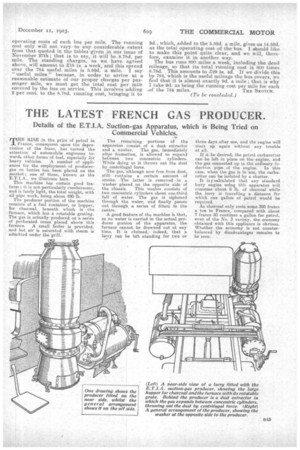THE LATEST FRENCH GAS PRODUCER.
Page 29

If you've noticed an error in this article please click here to report it so we can fix it.
Details of the E.T.I.A. Suction-gas Apparatus, which is Being Tried on Commercial Vehicles.
THE RISE in the price of petrol in France, consequent upon the depreciation of the franc, has turned the attention of automobile engineers towards other forms of fuel, especially for 'heavy vehicles. A number of appliances for the employment of producer. gas on lorries has been placed on the market; one of these, known as the E.T.I.A., we illustrate here.
This machine has certain good features; it is not, particularly cumbersome, and is fairly light, the total weight, with all pipe work, being about 490 lb. The producer portion of the machine consists of a fuel container, or hopper, for charcoal, beneath which is the furnace, which has a rotatable grating. The gas is actually produced on a series of perforated cones placed above this furnace. A small boiler is provided, and bot air is saturated with steam is admitted under the grill. The remaining portions of the apparatus consist of a dust extractor and a washer. The gas, immediately after formation; is allowed to expand between two concentric cylinders. While doing so it throws out the dust by centrifugal force.
The gas, although now free from dust, still contains a certain amount of smoke. The latter is removed in is washer placed on the opposite side of
the chassis. This washer consists of two concentric cylinders about one-third full of water. The gas is siphoned through the water, and finally passes out through a series of filters in the centre.
A good feature of the machine is that, as no water is carried in the actual producer portion of the apparatus, the furnace cannot be drowned out at any time. It is claimed,'. indeed, that a larry can be left standing for two or
three days after use, and the engine will start up again Without any trouble at all.
If it be desired, the petrol carburetter can be left in place on the engine, and the gas connected up to the ordinary in duction pipe. of the engine. In this case, when the gas is in use, the carburetter can be isolated by a shutter.
It is / calculated that any standard lorry engine using this apparatus will consume about 8 lb. of charcoal while the lorry is travelling a distance for which one gallon of petrol would be required.
As charcoal only costs some 300 francs a ton in France, compared with about 7 francs 50 centimes a gallon for petrol, even of the No. 3 variety, the economy obtained with this appliance is obvious. Whether the economy is not counterbalanced by disadvantages remains to be seen.
































